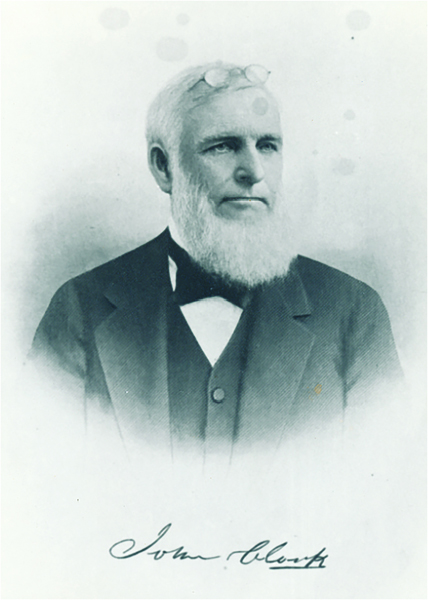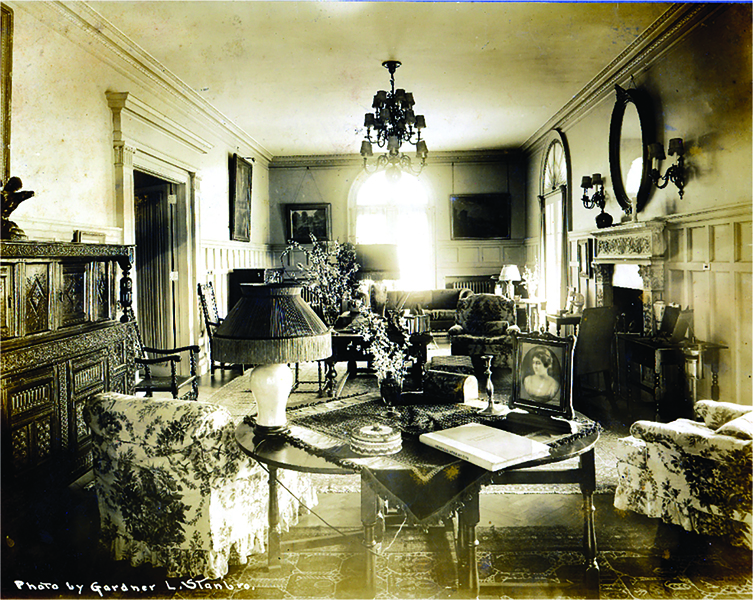By Jen Waller
Photography by Austin Britt
Deep in the heart of the Mississippi Delta, in a place once known as the “Golden Buckle on the Cotton Belt,” there stands a beautiful structure known as the Cutrer Mansion. The building is considered by many to be quite grand, but her story really begins with two very elite Southern families—the Clarks and the Cutrers.


John Clark, founder of Clarksdale
The Clark family saga begins in Mississippi with John Clark—planter, banker, merchant, and founder of the city of Clarksdale. Clark first came to the region with his father in November 1837 on a trip to New Orleans. While there, his father died of yellow fever, and Clark stayed in New Orleans for two years taken in by a man named Thomas Flint Porter, who was a logger and lumberman. At the age of sixteen, John Clark came up the Mississippi River to Port Royal (near Stovall, Mississippi), which was the county seat of Coahoma County, to go into the timber business with Thomas Porter. In time, Clark moved farther inland, worked hard, and saved his money. By 1848, he had saved enough to purchase over 101 acres from the government at $1.25 per acre. That land lies on the banks of the Sunflower River in the heart of the present-day business district of Clarksdale.
In 1854, John Clark married Eliza Alcorn, whose brother, James Lusk Alcorn, became a senator and governor of the state of Mississippi. At the outbreak of the Civil War in 1861, John Clark owned about 360 acres of land with 150 of it under cultivation. Once the war was over, he kept planting, opened a mercantile store, continued to buy and sell land, and started the town of Clarksdale in 1869, but the city of Clarksdale was not fully incorporated until 1882. By 1891, John Clark owned over five thousand acres of land, mostly in the vicinity of Clarksdale with about two thousand acres under cultivation. Over their thirty-nine-year marriage, John Clark and Eliza Alcorn Clark had eight sons and one daughter named Blanche Clark. Blanche was born on September 27, 1864, and she grew up in Clarksdale as one of the most popular belles in the Mississippi Delta.


Isaac Wesley Cutrer, father of John Wesley Cutrer
The Cutrer family story really begins with Isaac Wesley Cutrer, whose father had migrated to this country from France. Isaac Cutrer was born in Louisiana in 1816. He became a salesman in a large store, married America Vespucia Dunnica in March of 1842, and established the Cutrer brickyard. As his businesses expanded, he set up his own mercantile store in Osyka, Mississippi, and his own commission house in New Orleans. Isaac moved his family from Covington, Louisiana, to Osyka in the early 1860s. They had eleven children before his first wife, America, died in 1864. Their ninth child, John Wesley Cutrer, was born on July 5, 1857. He is the man who ultimately won the heart and hand of the only daughter of the founder of Clarksdale.
John Wesley Cutrer entered the University of Mississippi in the winter of 1874. He worked his way through college by tutoring other college students in the French language. He graduated from law school in 1878 and established a law office in Clarksdale. His younger brother, William Dunnica Cutrer, joined the law practice in 1885. They had offices in Friars Point and Clarksdale for several years.

The wedding of Blanche Clark and John Wesley Cutrer
In the spring of 1887, Isaac Cutrer and his new wife, Mary, received a letter in the mail from John Wesley describing his professional and political activities in Clarksdale as well as his courtship of John Clark’s daughter. He told them he had proposed marriage and she had accepted. They set the date for December 15, 1887, in Clarksdale, and he wanted his parents to attend. He also shared there would be many social events before and after the wedding, so they should be prepared for all of the activities.
The plan was for them to arrive in Batesville by train from New Orleans on December 10 and for John Wesley to take them by carriage back to Clarksdale. They would stay with Mr. and Mrs. John Clark in the guest quarters of their home. Mary Cutrer shared in her diary that she had to have six elaborate dresses made in New Orleans for the parties she would be attending in the Delta as well as several sets of travel clothes. She also wrote that when they finally pulled into the train station on December 10 that John Wesley had grown into a handsome, self-assured young man who was immaculately dressed.


On December 11, John Wesley’s parents met Blanche for the first time at a dinner in the Clark home. Mary Cutrer described Blanche as a stunning young lady with silky blonde hair, intelligent blue eyes, and an angelic face. Having recently completed her education at Mount Holyoke, where she studied music and literary subjects, Blanche was ready for this new chapter in her life.
While in Clarksdale, Isaac and Mary Cutrer attended parties, teas, and receptions almost around the clock until the day of the wedding. Mary said it was a continuous whirlwind of activities that included people from state government as well as local politics.
When December 15 finally arrived, the wedding was held in the Clark home. Blanche had twelve attendants, and the entire lower floor was decorated with flowers. When the ceremony was over, Mr. and Mrs. J.W. Cutrer departed by carriage for their honeymoon. It was all a glorious affair.
The early days of J.W. Cutrer and Blanche Clark Cutrer
By the time J.W. Cutrer and Blanche Clark married in 1887, he had been a successful criminal attorney in Coahoma County for almost ten years and had been elected as a state representative in 1884. For the majority of their marriage, the Cutrer family lived in a large red house on 2nd Street in Clarksdale, which was located at the present site of the Clarksdale Civic Auditorium. They had four children. Their first child, named Elise, arrived on December 22, 1888. That same year, Mr. Cutrer was elected as a state senator in Mississippi. He served two terms and served on the Constitutional Convention of 1890.


In August of 1893, their second child was born, John Clark Cutrer. He drowned in Moon Lake in June of 1923. In August of 1895, a second son was born named Reginald, and their last child came in October of 1897. They named her Blanche.
All during this time, J.W. Cutrer continued to develop his career. He became involved with the Yazoo-MS Delta Levee Board in 1896 as president and served on that board until 1904. He served on the school board from 1905 to 1911 and then went back on the levee board from 1910 to 1916 and also 1924 to 1932. During his lifetime, J.W. Cutrer was a plantation owner, a founder of the Clarksdale Savings and Loan Bank, and a successful lawyer and politician.
His wife, Blanche, became one of Clarksdale’s best known and most deeply loved women. She was cultured, refined, and gifted with unusual intellect. She was well traveled and enjoyed socializing. She had a charming personality that showcased the social graces of a true Southern belle.
The building of Belvoir
In 1916, J.W. Cutrer had the massive John Clark home rolled eastward on logs pulled by mules so he and Mrs. Cutrer could build a new house on top of the hill overlooking the Sunflower River. Once completed, it was called Belvoir, which means “beautiful view” in French.
Their new home was built as an Italian Renaissance style villa designed in a rectangle symmetrical shape with four built-in columns across the front. The roof was covered in terra cotta clay in a Mediterranean style that complements the white house perfectly. The designer was the acclaimed Memphis architect Bayard Cairns, who was educated at Columbia and had studied four years at the Ecole des Beaux-Arts in Paris under Pascal.


The Cutrer home became known as one of the most beautiful homes in the region. No expense was spared when building, furnishing, and landscaping the house. It had, and still has today, so many unique architectural details. For example, the first floor has high groined ceilings with ten intricate plaster sconces in the hallway and several detailed plaster cornices throughout the house. The floors of the entrance and the hallway are covered in black and white tile while the other rooms in the house have oak hardwood floors.
The walls of the east wing drawing room have an attractive wainscoting that stands over five feet tall, and the floors have been laid in a herringbone pattern. At the time, the room also showcased a hand-carved Italian marble mantel that was gorgeous. The dining room and the library also had beautiful mantels. But perhaps the most breathtaking feature in Belvoir is the collection of windows. There are eight large arched windows, and when built, there were fourteen French doors that opened from room to room or out to various points of the property. The sunroom on the east wing also had an indoor fountain and a beautiful red tile floor. The architectural details are truly superb and reveal the work of skilled craftsmen.
The beautiful imperial staircase led to the private residence on the second floor, which included six bedrooms, five bathrooms, and three sleeping porches. It had unique features such as a central vacuum cleaner system that collected dirt and debris within the house and then sent it through tubing installed inside the walls to a collection container in the attic. It was an amazing house.
End of an Era
The house and the family that lived there flourished, but financial strain and the Great Depression took a toll. One Sunday evening in 1932, Mr. Cutrer fell in the house. He died a week or two later. Then, almost three years later, Mrs. Cutrer passed in the spring of 1935. Soon after that death, the house closed its doors as a private residence. The youngest daughter, Blanche Cutrer Smith, was the last family member to own Belvoir. After almost ten years of trying to figure out what to do with the house and how to make it useful to the community, she sold it to the Catholic Church. She and her immediate family signed the deed in September of 1946 and, thus, an end of an era occurred.
Her son, the Rev. John Cutrer Smith of New York, is the last person alive today who lived in the house while it was still a private residence, and he is the one who has so generously shared his wonderful memories about his time there. Rev. Smith remembers it as a place of splendor. It was decorated by Charles Duveen of New York and was furnished in the European and British tradition. All of the downstairs rugs were antique Persian. The curtain fabrics in the living room, dining room, and library were English blocked linen, and the library was filled with classic books like his personal favorite Jane Eyre.
There were large gilt Italian mirrors, an eighteenth century French verdure tapestry, and family portraits and paintings throughout the house. Rev. Smith also tells stories about his extended family from Osyka coming to visit for weeks at a time and the fun parties that took place while they were there. He says most included small orchestras or jazz bands with well-known musicians like W.C. Handy performing such tunes as St. Louis Blues. It literally became a cultural hub in the Delta and the backdrop for a privileged life.
Looking back, he said he felt that he had seen so much of this “great world in miniature” by living in that house, and he missed it bitterly when they moved out in late 1935.
Today, the Cutrer Mansion in Clarksdale has become a precious time capsule for all to enjoy. The treasured memories and gifts have secured the legacy of an extraordinary Mississippi Delta family and helped an old building transform. And when paired with the stories of one of America’s greatest and most celebrated playwrights, Mississippi’s own Tennessee Williams, perhaps we can be transformed too.
Hope is the thing with feathers that perches in the soul and sings the tune without the words and never stops at all…Emily Dickinson D M



1 thought on “A Beautiful View – One of the Delta’s Storied Homes and Architectural Wonders”
My mother was a first cousin of Blanche Cutrer Smith’s husband and they visited Clarksdale in the early thirties. I remember she mentioned that they all dressed in evening clothes (tux etc.) every night.